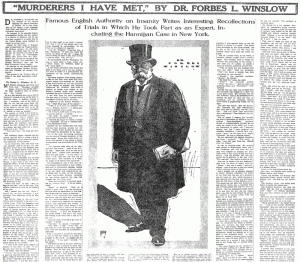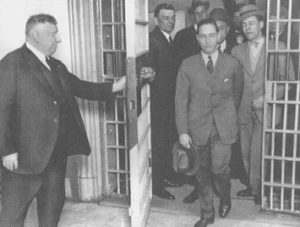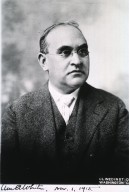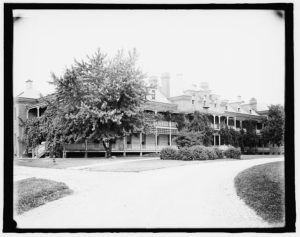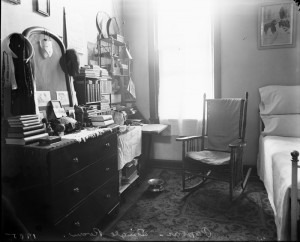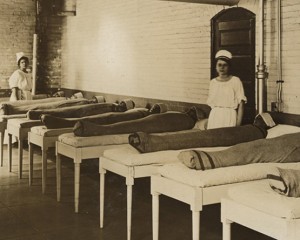Dr. William A. White was an undisputed leader in the field of psychiatry (see last post). He was St. Elizabeths’ superintendent for over twenty years, and implemented many innovations. St. Elizabeths endured its own cycles of overcrowding, scandals, and investigations, but it was generally considered one of the leading institutions of its kind. It attracted some of the country’s best psychiatrists and researchers, who wanted to be affiliated with the asylum and its good reputation. Continue reading
Tag Archives: Dr. William A. White
An Important Alienist
Alienists became more important as experts to draw on after psychiatry became more established.
Dr. William A. White, for many years the superintendent of the federal government’s first hospital for the insane, St. Elizabeths, was an especially important figure.
His book, Outlines of Psychiatry, became a classic in its field and was used as a textbook for many years. Continue reading
Insanity Defense Becomes More Common
Though President Garfield’s assassin, Guiteau, did not save his life based on an insanity defense, the plea became more common.
In 1924, Dr. William A. White, superintendent of St. Elizabeths Hospital for the Insane, testified in another sensational insanity-plea trial: that of Nathan Leopold and Richard Loeb for the kidnapping and murder of a fourteen-year-old boy named Robert Franks. Continue reading
Compassionate Doctors
Though many abuses toward patients were either condoned or ignored by senior staff, some doctors cared very much about patient abuse.
When Dr. William A. White took over as superintendent of St. Elizabeths (the federal government’s hospital for insane soldiers, sailors, and citizens of Washington, D.C.), he immediately issued a terse letter absolutely revoking use of the saddle (a harness fashioned around a patient in bed and tied so that he/she could not raise up) as a restraining device. Continue reading
Another Contrast
It perhaps isn’t quite fair to compare a federal insane asylum like the Canton Asylum for Insane Indians with a private institution catering to the wealthy. (See last post about McLean Asylum for the Insane.) However, the government did have another insane asylum, and it was also quite different from the one at Canton. St. Elizabeths had a training school for nurses, quarantine rooms, and a full hospital where operations ranging from appendectomies to hysterectomies were performed. It was one of the first asylums in the country to appoint a pathologist to its staff, and one of the first to institute therapeutic hydrotherapy.
At about the time that the Canton asylum opened, Dr. William A. White arrived at St. Elizabeths. He created a clinical director position, and organized a scientific department which eventually included a pathologist, psychologist, histopathologist, and a number of assistants. The department published their research in the form of an annual bulletin. St. Elizabeths also trained surgeons from the Public Health Service and Marine Hospital Service to work on Ellis Island (helping discover insane immigrants). The hospital shared its research with the U.S. Army and Navy to help bring military psychiatry into their respective branches. The Canton Asylum for Insane Indians was much smaller than St. Elizabeths and perhaps couldn’t be expected to do the same things. However, its staff could have done much more research on mental health issues in a unique population than it did, and been much more involved with its peer organizations that it was. Instead, the asylum’s most significant staff member, Dr. Harry Hummer, allowed the facility to stagnate into a backwater institution that helped its patients very little.
______________________________________________________________________________________
Eggzact Details
Insane asylums were subject to a great deal of scrutiny and interest, and no detail was too small to catalog. Inquiry by the surgeon general into the number of eggs served at the Government Hospital for the Insane (St. Elizabeths) during 1904 revealed the following:
January – 3463 and 1/2 dozen
February- 3148 dozen
March – 3569 dozen
April – 3972 and 1/2 dozen (the high number was due to Easter falling within the month)
Dr. William A. White, St. Elizabeths’s superintendent, said that eggs were served in “considerable quantities” in the wards with acute cases of insanity. He stated that “from one diet kitchen 122 patients are served with 152 dozen eggs per week.”
Though White did not attribute a specific therapeutic value to eggs, it was generally believed that eggs and milk were exceptionally nutritious fare for insane patients.
________________________________________________________

